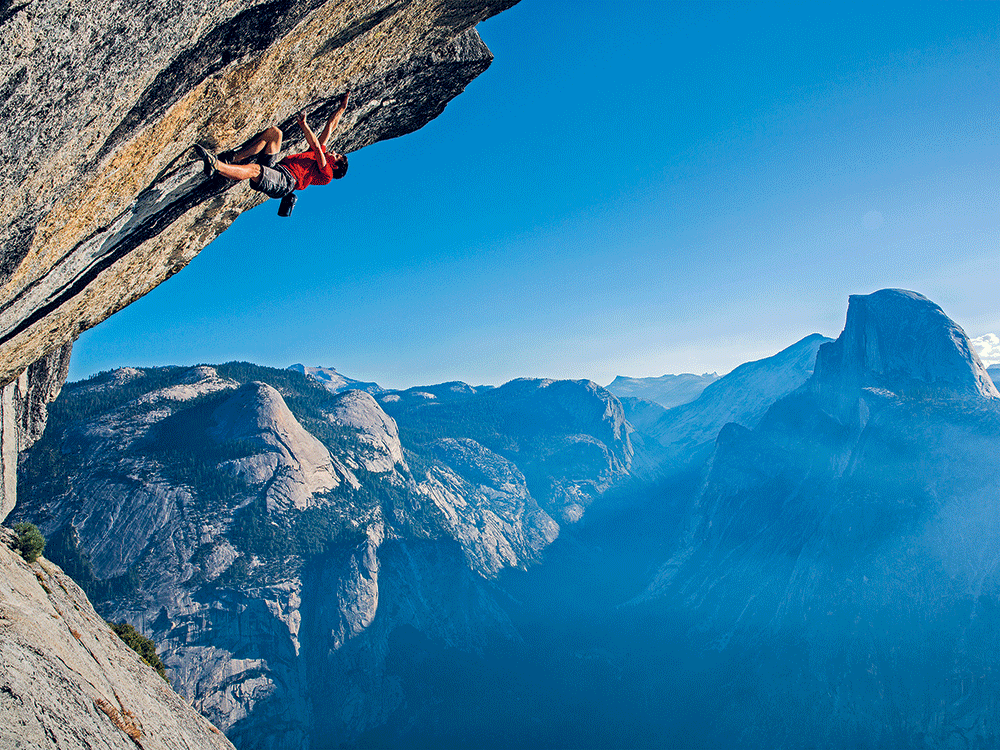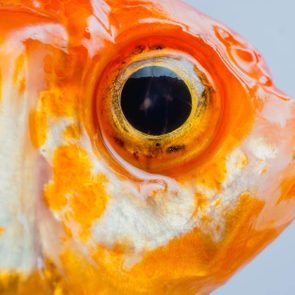To Conquer My Fear of Heights, I Did the Scariest Thing I Could Imagine
In this excerpt from her book Nerve, Eva Holland shares what skydiving taught her about herself, and how fear holds us back.
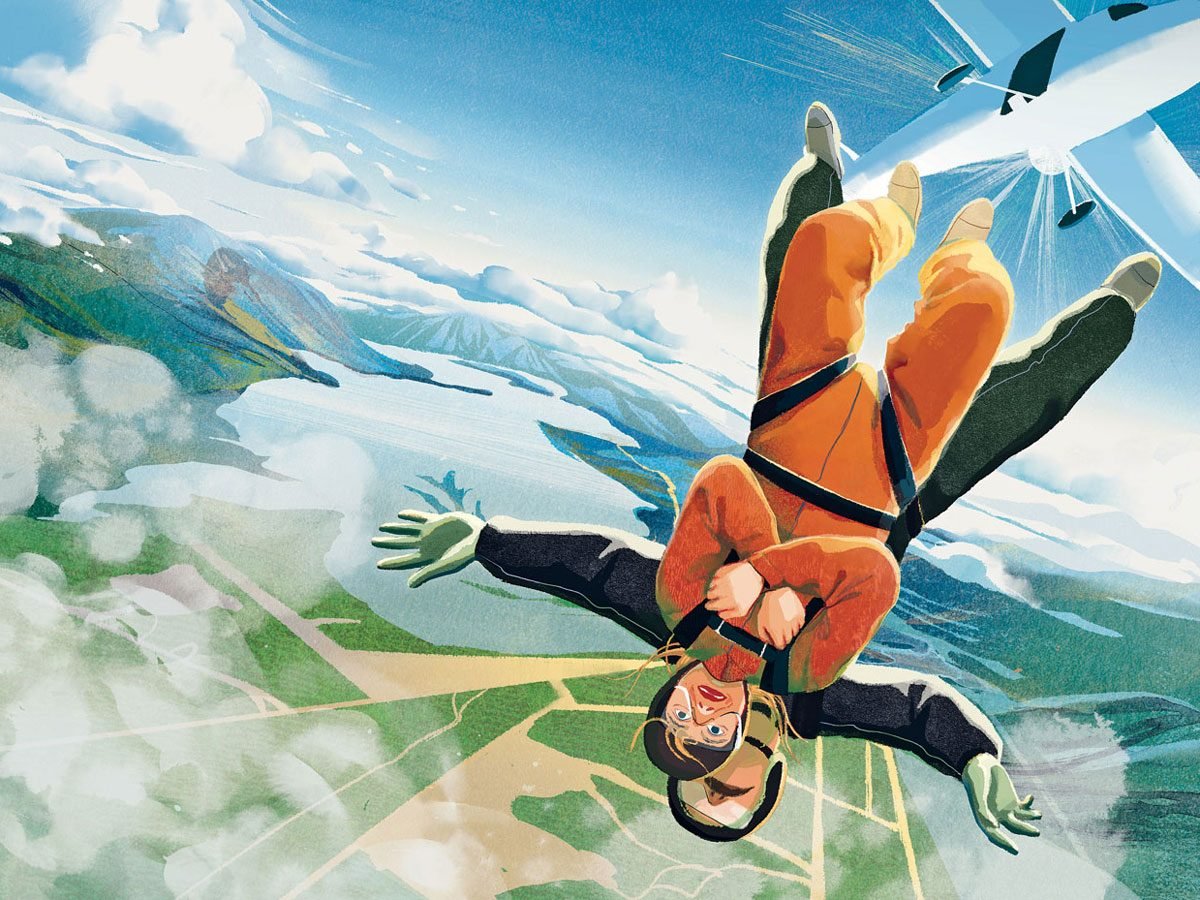
In the last moments before I climbed into the Cessna, I turned and faced a young, bearded man who was pointing a video camera at my face. I wore a jumpsuit made of panels of fluorescent orange and green fabric, the colours faded by years of sun and wind. A pair of goggles and a leather helmet were strapped on my head. “Why are you here?” the man asked.
I took a deep breath. “My name’s Eva,” I said, speaking to the camera lens, “and I’m here to face my fear of falling from heights.”
I crawled into the tiny plane, awkward in my elaborate harness. Only the pilot had a seat—all the others had been removed—and I sat on the floor behind him, facing backwards, spooning with my divemaster, Barry. Another pair climbed in beside us: divemaster Neil and his charge, Matthew, a first-time skydiver like me.
They sat by the open doorway, and Matthew and I bumped fists as the little Cessna rattled its way down the gravel runway. Matthew looked elated. I knew I was supposed to be excited, too, but I couldn’t get there. For the moment, I existed in a bubble of cold calm. That, I figured, was preferable to the likely alternative: wild, hair-tearing panic.
I’d tried to work on my fear of heights over the years, but the matter never seemed urgent. Then, in February 2016, during a weekend of ice climbing with friends in British Columbia, I panicked—an irrational force took over my body and I refused to move any further. My fear put my own life, and the safety of others, in danger. I didn’t want my terror to control me that way ever again.
I’d arrived at the small airstrip in the village of Carcross, Yukon, several hours earlier. Carcross is an hour’s scenic drive south of my home in Whitehorse. Among its few claims to fame is the Carcross Desert, billed as the world’s smallest, a tiny collection of soft, rolling dunes surrounded by snow-etched mountains and boreal forest. Every summer, a skydiving outfit based in British Columbia caravans up here for a couple of weeks and offers Yukoners the chance to jump out of a plane, plummet through free fall, deploy a parachute and eventually land in the forgiving embrace of the tiny patch of sand.
The pro skydivers live by the airstrip, just outside the village, for the duration. The vibe of their encampment is somewhere between summer weekend camp-out and itinerant circus troupe. They gather in a jumble of tents, U-Hauls, cars, RVs and trucks loaded with campers. Barry is their patriarch. When I met him, he’d been jumping for 39 years, including more than 2,000 tandem jumps with clients. He had grey hair and a grey moustache, a big belly and a bigger voice. He’s not what you picture when you think “professional thrill-seeker,” but his age and experience made me more comfortable than any young gun could have. As the saying goes, there are old pilots and there are bold pilots, but there are no old, bold pilots.
I was here because my three most potent physical fears were of heights, speed and falling. And there was nothing, I figured, that combined all three as effectively—or as horrifically—as skydiving. My notion was to take a blitzkrieg approach to facing my fears. I would force myself to do the scariest thing I could think of, in a full sensory assault on my fear response, and if I came out the other side, I would be changed, right? Empowered. That was the idea. So far, I just felt sick and scared.
Barry introduced us first-time jumpers to the gear we’d be using, how the various safety mechanisms worked, and informed me that if I tried to grab on to the plane as we jumped, latching on in a last-minute panic, he would break my fingers to release my grip if he had to. His tone suggested that it wouldn’t be his first time doing so.
I signed the bluntest waiver form I’d ever seen. “Sport parachuting is not perfectly safe,” it read. “We cannot and do not offer any guarantees. We do not guarantee that either or both of your parachutes will open properly. We do not guarantee that individuals at SkydiveBC North or Guardian Aerospace Holdings Inc. will function without error. We do not guarantee that any of our backup devices will function properly, and we certainly do not guarantee that you won’t get hurt. You may get hurt or killed, even if you do everything correctly.”
The form did nothing to calm me down. I signed my name and handed it over. With the paperwork completed, there was nothing much left to do but wait my turn—and stew.
When the Cessna was ready for us, Barry showed me how we would enter and exit. The plane was tiny, and when we launched ourselves through its low doorway, we would be harnessed together. There was a careful protocol to follow. I’d pictured us stepping out of a full-height doorway, or even a yawning garage-style opening, like in the movies. But the small plane, plus our joined bodies, demanded an awkward crouch-and-roll. For some reason, the sheer impossibility of the manoeuvre—really, I was going to tandem-somersault out of a tiny opening in midflight?—calmed me down. This couldn’t be real. It seemed like a joke.
Then, suddenly, it was time. I pulled on my fluorescent jumpsuit, helmet and goggles and got cinched into my harness. I faced the camera, declared my intentions and climbed into the plane.
We were airborne, rising up above the desert, with Carcross and Bennett Lake stretching away into the mountains. The landscape below me was familiar, comforting. Countless times, I had hiked it, biked it, paddled it, driven it, flown over it in commercial jets. I’ve never minded flying; it was the falling I was worried about. I tried to breathe deeply and focus on the scenery. There was the train bridge. There was the beach. There was the highway leading home.
Somewhere on the way up, shivering with cold and fear, I noticed something: I wasn’t sweating. I had expected to be clammy with fear-sweat, but instead I was bone dry. Perspiration was on my mind because I’d recently heard about a scientific study that used the sweat of first-time skydivers to answer a single question: can humans smell fear?
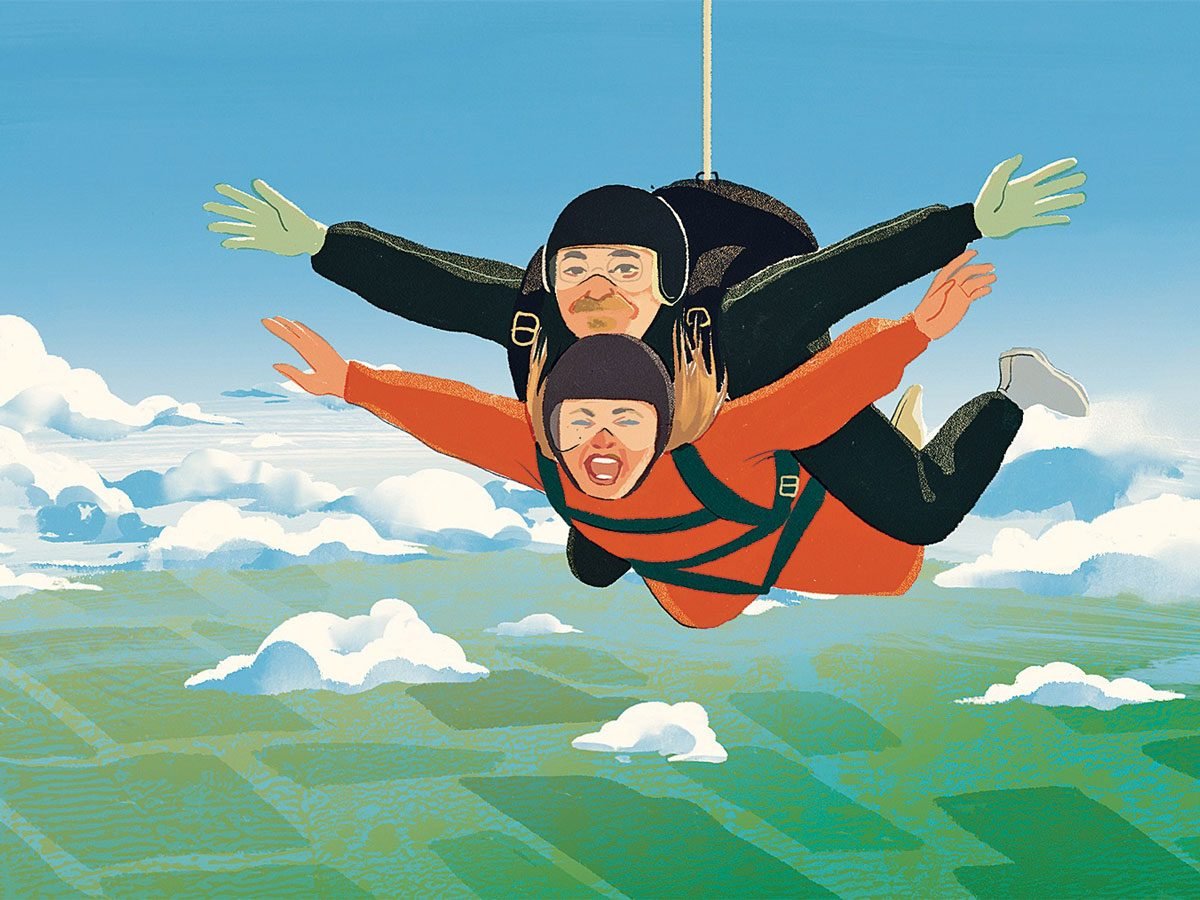
We’ve long known that animals can “smell” fear on each other, although in casual, non-scientific conversation, we tend to talk about it in terms of predators smelling fear on their prey. That’s a misunderstanding of the phenomenon. What happens is that prey animals unknowingly emit what are known as alarm pheromones, airborne chemical cues intended to silently warn other members of their species, alerting them to nearby predators and other potential dangers.
Several studies have pointed to the possibility that humans, too, can signal their fears to one another by chemical means, through our sweat. Two of those studies showed that test subjects were able to distinguish between the sweat of a person who was watching a scary movie and a person who was watching something non-frightening. Another found that subjects who had smelled the sweat of scary-movie-watchers demonstrated heightened cognition in the presence of a potential threat. Still more studies found an increased startle response in people who’d been exposed to someone else’s fear-sweat, as well as a higher likelihood of perceiving facial expressions as fearful or negative. The takeaway was clear: people who had smelled another human’s fear-sweat were primed for a fear response of their own.
But those studies were all based on observed behaviours. A team of researchers led by Lilianne Mujica-Parodi, of Stony Brook University in New York State, wanted to look deeper. They decided to use an fMRI scanner (which tracks blood flow to measure brain activity in real time) to determine whether exposure to human fear-sweat provoked a measurable reaction in another human’s amygdala, the key brain structure that triggers our fear response.
They started by collecting sweat from 144 people who were participating in a first-time tandem skydive. Then they used those same 144 individuals as their own controls, collecting their sweat after they’d run on a treadmill for the same length of time that the skydive had lasted and at the same time of day.
“Because the tandem master controlled the descent,” the researchers wrote later, “the skydiving condition produced a predominantly emotional but not physical stressor for our sweat donors, while the exercise condition produced a predominantly physical but not emotional stressor.” (They confirmed the first-timers’ emotional stress by testing their levels of cortisol, a hormone released by our adrenal glands in connection with our fight-or-flight response. Sure enough, they had spiked.)
Then came phase two: presenting the sweat samples to test subjects and using fMRI scans to view how their brains reacted in real time. They showed that when a subject inhaled sweat taken from a stressed or fearful person, their amygdala was activated. In a secondary procedure, they had also shown that what was happening wasn’t about smell, exactly. Our noses can’t distinguish between fear-sweat and regular, everyday exercise-sweat, but our brains react differently to the two. That’s what’s known as a chemosensory reaction: the pheromones in the fear-sweat trigger our emotional, not our olfactory, sensors.
Then they took it one step further. The researchers hooked another group of test subjects up to an electroencephalogram (EEG) machine. Basically, an EEG lets researchers see which parts of the brain are reacting to a given stimulus. Once they were wired and ready, the subjects were exposed to both fear-sweat and exercise-sweat while being shown a range of images of human faces, with a carefully manipulated spectrum of expressions ranging from neutral to angry.
The results were striking. When they were inhaling the exercise-sweat, the subjects’ brains only reacted strongly to the angry faces, treating them, but not the neutral faces, as potential threats. But when they inhaled the fear-sweat, subjects reacted strongly to the whole range of faces, from those with neutral expressions to ambiguously angry to clearly angry. The suggestion, the researchers wrote, was that the fear-sweat triggered the brain to create a sort of heightened vigilance in the subjects, a greater attention to the environment around them.
We can, indeed, “smell” fear on each other. And that chemical alert system prepares our brains to react to incoming threats.
When we spoke, I asked Mujica-Parodi why she had chosen skydiving as a way to gather the fear-sweat she needed. “Skydiving was a way to induce actual danger in a way that was also ethically sound and scientifically sound,” she told me. “The nice thing about skydiving is that it’s an experience unlike anything you’ve ever encountered before. Evolutionarily, there’s no animal that enjoys the feeling of being dropped, and it’s also highly controlled.”
I asked Mujica-Parodi if she’d ever gone skydiving herself. “I did force myself to jump, and I felt very nauseous,” she said. “I would not say that I enjoyed it.”
The ascent to 3,050 metres seemed to take hours, and as we climbed, the weird out-of-body calm I’d felt on takeoff seeped away.
It was like coming out of shock, losing that numbed protection and feeling the full pain of an injury for the first time—only instead of pain, I felt a terror that rose through my body until it reached my lungs, my throat and my brain and threatened to choke me.
Barry, behind me, sensed my growing tension—no surprise, since we were pressed together like a pair of lugers on a sled. He periodically squeezed my shoulder and pointed out landmarks below. As we neared jump height, the Cessna circled around a large cloud, skirting its edge.
“You might be a lucky girl and get a cloud jump,” Barry said.
I did not want a cloud jump.
The pilot announced that we were nearly in position for Neil and Matthew’s jump. They shimmied toward the gaping hole where the plane’s door should have been and nudged themselves awkwardly into a spooning crouch on the lip of the doorway.
Seeing them inch toward open space was nauseating, and I looked away. I couldn’t watch them vanish into the sky; I stared at the plane’s riveted metal wall instead. The pilot dipped the plane slightly to the right, tipping Neil and Matthew out the door, and then, liberated of their combined 270 pounds, the Cessna sprang back suddenly to the left. My stomach clenched and jerked and I swallowed hard.
Now it was our turn. Barry directed me to roll over and scuttle into position as the pilot got us lined up for another jump. My breath came fast; I struggled for control. I desperately wanted to shout, “No, no, I changed my mind. I don’t want to do this!”
I clenched my jaw. I knew that if I said the word, they would take me back down to the ground, keep my money and let me walk away. The whole day would be for nothing.
Eventually I got myself in place, hunched over with my kneecaps level in front of the doorframe, with Barry behind me. I tried to unfocus my eyes so I couldn’t see the opening and the endless air next to me, the ground far below. Over the roar of the wind and the plane, Barry shouted last-minute adjustments to the pilot, getting us lined up just right. “Give me five left! Five right!” The seconds stretched out while I fought the urge to quit. I had the sensation of trying to hold up some massive weight, my strength ebbing away, moment by moment.
Finally, Barry put his right foot out on the narrow metal step fixed to the plane’s fuselage, below the open door frame, and yelled for me to do the same. It took me three tries—the wind first blew my foot behind, then in front, before I finally lodged it against his. Next I had to scooch around so my left knee pointed out over the lip of the doorway and lock both my hands onto my harness, gripping a pair of handles at shoulder height. I was glad to have something to hold on to. Ever since Barry had promised to snap my finger bones if need be, I’d had a recurring vision of myself reaching out in panic as we exited the plane and fastening on to the door frame or a strut with a vise grip fuelled by fear, pulling the Cessna off balance and risking everyone’s lives.
We were halfway out of the plane, perched on the very edge of jumping. I was past the bail-out point now. I closed my eyes and tried not to hyperventilate, tried not to think about what was coming.
All I could do was stay limp and trust Barry to get us in the air—actually participating in our exit from the plane was beyond me. I felt him rocking back and forth to get our momentum up, heard him yell something, but I was deep in my own head. Then we rolled out of the plane and into space.
Barry had urged me to keep an eye on the Cessna as I somersaulted out of it. Watching the plane appear to fall away from you when you were the one plummeting was, he assured me, one of the coolest parts of a jump. But I had no desire to watch the earth and the sky spin around me. I kept my eyes shut hard until I could feel that Barry had stabilized us in free fall.
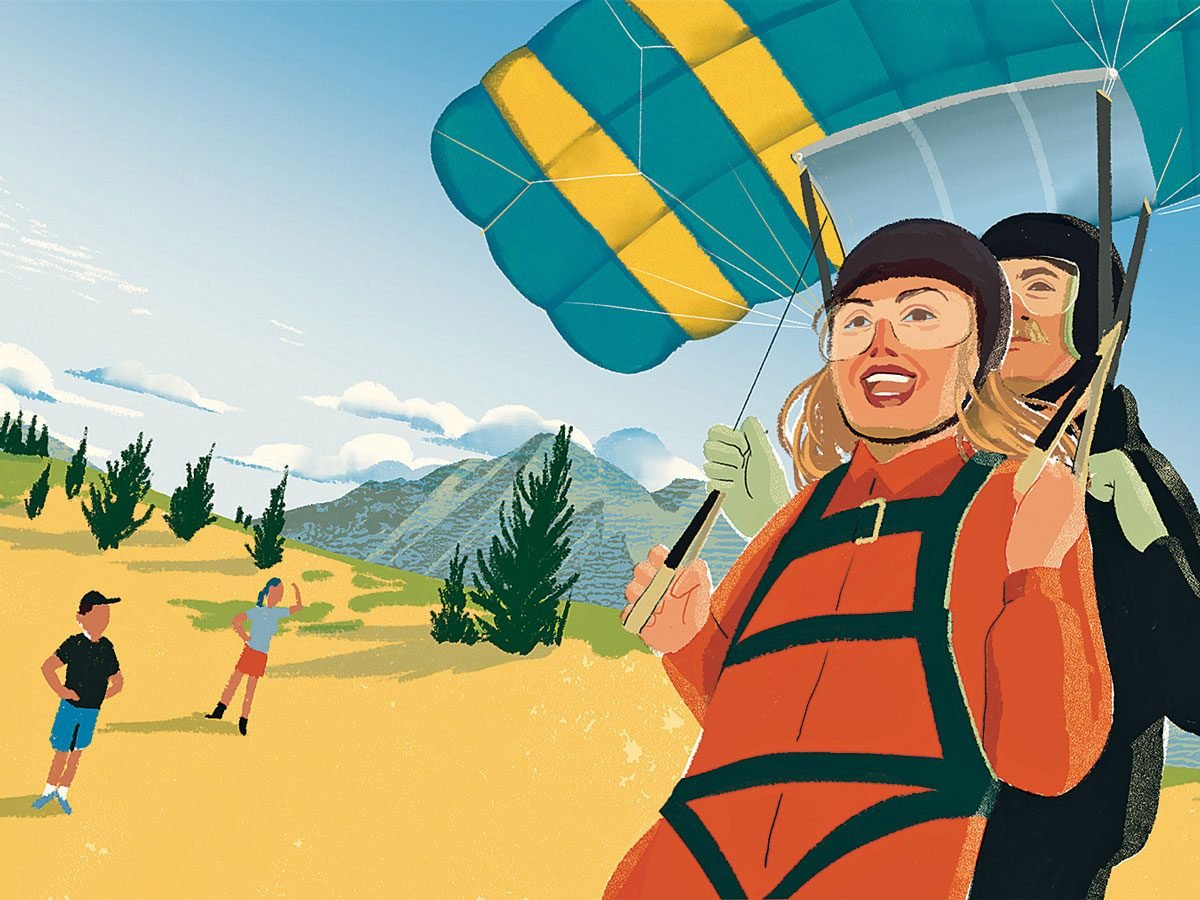
I felt him tap me on the shoulder, then again, and yell something in my ear, and I peeled my hands off the harness handles and thrust my arms out wide, like I was supposed to. I tried to think about arcing my body into a slight bow: feet together, head up, my belly pointing the way down. I stared at the ground rushing up at us, and suddenly I opened my mouth and spoke for the first time since we’d started the flight up.
“Holy shit!” I yelled, and the wind seemed to tear the words out of my mouth to make room for more. “Holy shit! Holy shit! Holy shit!” A small part of my brain noted, amazed, that I could even hear myself, could even produce audible speech, with the force of the air roaring by me. (Later, I would learn that we had reached a peak speed of 163 kilometres per hour.)
I screamed those same two words over and over through our entire 37 seconds of free fall. Once I got started, I couldn’t seem to stop. My voice got hoarse, my throat raw. I kept hollering. Dimly, over the sound of my own swearing, I heard Barry say something about our chute, then a force seemed to pluck at us from above—not a hard jerk, but now my feet were dangling below me and I could feel my weight pushing down on the crotch straps of my harness.
I stopped yelling. Barry reached forward and offered me the straps that controlled the parachute, to let me steer. It took me a couple of tries to put my shaking hands through the loops, and I was too weak to pull effectively. I could feel him pulling the cords for me from above.
Other jumpers had described the long, leisurely parachute descent after free fall as relaxing. But I couldn’t relax—I was too aware of my weight in the harness, my feet dangling, the familiar landmarks far below me. There was the train bridge. There was the beach. There was the highway leading home. Barry spun us around and I felt sick, hated him for a moment, and quavered that I didn’t like that. The fall went on and on. Finally we neared the desert and Barry took over steering entirely, reminding me of my role in landing.
He twisted us from side to side, tacking like a sailboat to shed speed as we came in over the dunes. Then he gave me the signal to pull my knees up (I did my shaky best) and pull down hard on the chute straps. I braced for impact, but my feet never touched—suddenly I was on my belly in the sand, Barry on top of me. He unclipped the right waist clip so he could roll off of me as the ground crew approached, cheering, and freed me completely.
The crew and other jumpers clustered around; someone helped me to my feet. I tried to smile, but my cheeks and lips felt as wobbly as my arms and legs. I stared at the sand and dug around inside myself, trying to find some pride in my accomplishment, some kind of silver lining with which to cover up the apparently bottomless chasm of fear I carried inside me.
Later, after I’d stripped off my harness, helmet and jumpsuit, after I’d calmed down enough to safely attempt the drive home, I did find some pride. I had done it, after all. I hadn’t backed down, pulled the plug at the last minute and forfeited my money and my dignity. I hadn’t clutched on to the airplane as we rolled out of it, killing us all. I hadn’t screamed the entire way down.
Excerpted from Nerve by Eva Holland. Copyright © 2020 Eva Holland. Published by Allen Lane Canada, a division of Penguin Random House Canada Limited. Reproduced by arrangement with the Publisher. All rights reserved.
